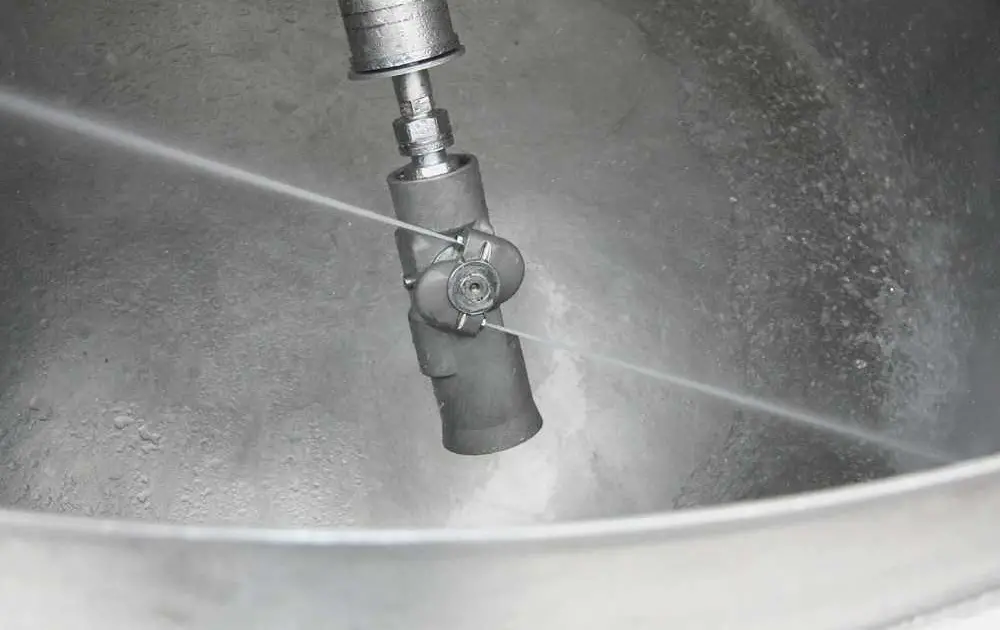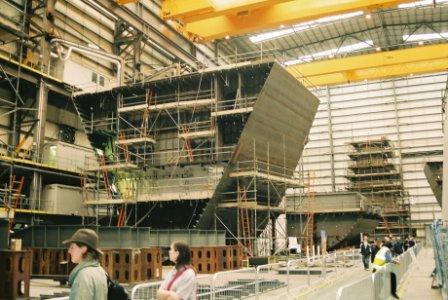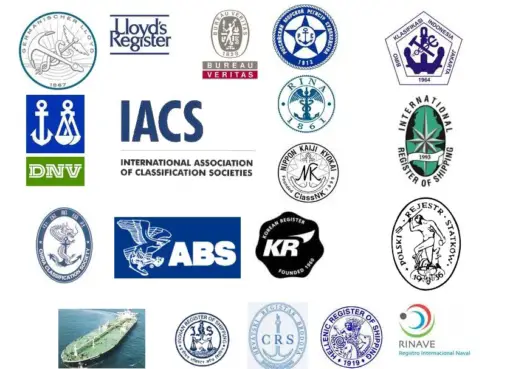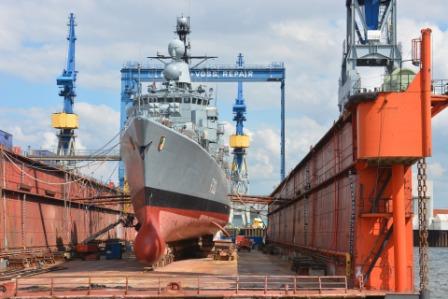Crude oil washing (abbreviated to the COW) was developed for the tanker industry in the early 1970’s. Being the result of increasingly restrictive legislation and the need to stop oil pollution completely. Improved methods were needed to clean the tanks than by mere salt water. Many experts in the oil field wanted all oil tankers to completely stop carrying salt water ballast in their cargo tanks. The implication of this line of thinking was far-reaching, as it meant very high transportation cost as the cargo carrying capacity of the tanker would reduce and heavy modification was required to existing ships to convert cargo tanks to ballast tanks. A series of experiments were conducted earlier – one of which was cleaning the ship’s tanks with naphtha and this proved to be very effective. However, naphtha is expensive and not easily available on crude oil tankers so this method of cleaning tanks could not be adopted.
The next best alternative was to clean the tanks with the crude oil cargo itself either in port while the ship is discharging or at sea in between discharge ports.
When a tanker carries crude oil as cargo, some waxy asphalt elements of the cargo settle down or adhere to the bulkheads and structures. These remain behind when the cargo is discharged. Crude oil is a good solvent, so when used as a washing medium it is effective in dispersing and suspending these sediments in the oil, which then gets discharged with the cargo leaving behind a cleaner tank. Thus the need to water wash tanks for sludge control was eliminated
However, water washing will be necessary if the tank is to be used for clean ballast or man entry is planned. But here again the water washing will be easier and faster, smaller amounts of wash water will be needed and the number of slops (oily water) remaining after decanting will be reduced.
Initially, it was very hard to convince the port authorities and terminals as it was a hazardous operation and this had to be undertaken in a very controlled atmosphere. As a result of carefully monitored and controlled experiments the currently accepted method of tank washing with crude oil during the discharge has been accepted by most oil terminals and port authorities and approved by IMO.
MARPOL provides the specific design criteria, operational requirements and control and enforcement procedures for the crude oil washing of cargo tanks of crude oil carriers.
Requirements for crude oil washing
- The ship should be fitted with an inert gas system and the ability to control and limit the amount of oxygen in the cargo tanks (An upper limit of maximum 8% is permissible).
- All the cargo tanks should be fitted with fixed tank washing machines which may be mounted on deck or inside the tank (submerged machines). These should be connected with fixed piping systems connected to pumps located in the pump room and not in the engine room.
- There should be a means to positively check that the tank bottom is clean and dry on completion of the operation.
- An administration approves the crude oil washing operations and equipment manual
- Personnel assuming overall charge of crude oil washing operations and also those assisting should be appropriately trained.
Objectives of crude oil washing
- A safer operation which minimizes the risk of pollution.
- A high standard of tank cleanliness.
- The best possible cargo outturn. (Cargo out turn is the quantity of cargo finally received by the cargo receiver in his tanks which will be generally less than the cargo loaded because of loss due to evaporation during the voyage and the sediments and un-pumpable sediment left behind in the tanks on completion of discharge).
It may be worthwhile to mention that when effective crude oil washing is done the sludge and sediment remaining on board is approximately 0.1% of the cargo carried whereas the remnants are about 1% if the COW has not been done.
PLEASE NOTE
- The minimum extension of time in comparison with normal discharge procedures.
Before we go further let us discuss the advantages and disadvantages of crude oil washing.
Advantages of crude oil washing
Chances of pollution are reduced because:
- Dirty ballast carried in a tank after COW will have much less oil and oily sediments.
- Less wash water is required to clean tanks for ‘clean ballast’ or for man entry purpose.
- Routine water washing of tanks for sludge control is largely eliminated.
- The crude oil residue left clinging to the sides of the tank and internal members are reduced substantially.
- The build-up of sludge and wax in the tank bottom is largely eliminated. This, in turn, promotes efficient draining of tanks thereby reducing stripping time.
- Experience has shown that the cargo out-turn has been much better in a crude oil washed tank than a non-crude oil washed tank.
- With the reduction in water washing of tanks, corrosion inside the tank is reduced. Ship’s cargo carrying capacity increases because:
(1) Fewer slops retained on board
(2) Sludge build-up in the tanks prevented.
- Cheaper tank cleaning.
- With the reduction in the need for tank cleaning during a voyage, more time will be available for ship’s maintenance and this will lower overall operating cost.
- Sludge in a tank can cause pockets of hydrocarbon vapors, which in turn can prolong a gas freeing operation. With efficient crude oil washing, this possibility is reduced to a minimum.
- Reduced preparation time for drydocking. Previously the preparations needed for drydocking used to be a very tedious as there usually was a large amount of sludge accumulation inside the cargo tanks. This had to be manually demucked and removed. With the advent of the COW, the sludge accumulation has considerably reduced and hence preparation time was drastically cut.
Disadvantages of crude oil washing
- It does not eliminate completely the need to clean tanks with salt water whether it be for clean ballast or for entering a repair yard.
- The ship’s pipelines cannot be gas freed.
- COW can be carried out only if the ship is fitted with an inert gas system and fixed tank cleaning machines designed for crude oil washing. Older and smaller ships may not be able to undertake COW without major modification and large expenditure.
- It has to be noted that all crude oils are not suitable for crude oil washing. Hence only suitable crude oils can be used.
- COW is normally done during discharging. This prolongs the normal discharge time of the ship at the discharge terminal. If the entire ship is washed the discharge time can increase as much as 25% but the oil recovered will not be in proportion to the time lost during COW.
- A system failure like may often result in COW not being done. This might delay the ship as cargo tanks carrying ballast on ships fitted with COW system should be crude oil washed before ballasting.
- The COW lines may be pressurized to about 10-12 kg/cm2 during an operation. Any leakage from the COW line on deck that is not detected in time can cause a pollution incident in port.
The frequency of crude oil washing
- When the tanker is chartered the charterers or cargo receivers insists that during discharging the ship must do 100% COW. In such a case all the tanks have to be crude oil washed.
- In the absence of any instructions from the charterers or receivers, according to MARPOL, during every discharge, it is required to at least crude oil wash the tanks designated to carry any ballast water during the voyage. In addition, it is usual to crude oil wash about 25% of the remaining tanks on a rotational basis for sludge control. For the purpose of sludge control, a tank need not be crude oil washed more than once in every 4 months.
- When the ship is expected to dry dock – all tanks must be crude oil washed followed by a water wash before gas freeing.
- Apart from tanks carrying ballast, if there is a need to do man entry inside any of the other tanks for inspection, repairs or maintenance, then the tank has to be crude oil washed, water washed and then gas freed before man entry.
- MORE FREQUENT COW WILL MAINTAIN BEST TANK CLEANLINESS AND MINIMISE THE POTENTIAL FOR BLOCKING OF THE LIMBER HOLES OR TANK SUCTIONS DUE TO SLUDGE BUILD UP.
CRUDE OIL WASHING METHODS:
Crude oil washing can be carried out in either of the following ways during cargo discharge:
- Single stage washing
- Multi-stage washing
Single stage washing:
- This is very similar to washing tanks with water as explained in task 2.2.2. As the name suggests, the washing of each tank is done non-stop in one single sequence. This is the only method feasible with non-programmable fixed machines.
- The tank is first discharged completely or almost completely and washing is started.
- No build up of liquid level in the tank is allowed and the tank should be continuously stripped during the washing.
- If the stripping is not efficient – the sludge and sediments may remain at the bottom. If there is a build up of oil in the tank – washing should be stopped and tank stripped dry before recommencing the wash.
- To facilitate proper stripping, educators, stripping pumps, cargo pumps using vac-strip or prima vac system are usually used.
- It is very important to monitor the tank bottom during the entire washing operation to ensure that the strippers are coping up with the liquid input from the machines.
- This type of single stage washing takes more time than multi-stage washing in a discharge port since washing of a tank can be started only after the tank is completely discharged.
- This is particularly useful between discharges between two ports or between lightering operations.
Multi-stage washing:
- Multi-stage washing means washing the internal areas of the tanks in stages as the areas get exposed during discharge. This happens as the level of liquid in the tank falls during discharge.
- This type of washing can only be done if the tank washing machines are of the programmable type and washing angles could be manually set.
- Most tankers fitted with crude oil washing use this type of washing.
- Washing can be done either by two-stage or three-stage washing.
Two-stage washing:
- Tank washing is done in two stages – the upper part of the tank is washed first known as the top wash and then later the lower part of the tank is washed known as the bottom wash.
- The top wash is started when the tank is about 2/3rdempty and discharging of the remaining 1/3rd is in progress.
- During the top wash the fixed machines are set to wash between 120º and 50º that is from the deckhead of the tank to the side of the tank just above the level of the liquid in the tank.
- Washing is usually started at 120º and allowed to go to 40º, allowing for a 10º overlap between the top and the bottom wash.
- The pressure on the crude oil washing line is usually maintained between 10 – 12 kg/cm2 and a cargo pump is used to supply crude oil to the washing line.
- All wax and clingage drop into the cargo at the bottom and is discharged ashore.
- Normally the machines are run for 1½ cycles, so the top wash the machines are run from 120º to 40º, then again to 120º and back to 40º meaning every part of the tank is usually covered by the gun 3 times. This again depends on the crude cargo that the ship is carrying – whether clean or dirty and the condition of the tank. If required extra cycles are given( time permitting).
- The speed of the machine depends on the wash pressure, which when optimum should take about 40 minutes to complete the top wash. There is a gear setting of the machine that also can be adjusted manually, to set the speed of the washing cycle.
- By the time the top wash is complete, the tank would have been discharged completely and would be ready for the bottom wash. Alternatively, a top wash of another tank is started. This way initially the top wash of all the tanks may be completed first after which bottom wash of all the tanks can be done. The sequence is normally planned in advance and it depends on the discharging sequence.
- To carry out the bottom wash the machines are again set to operate between 50º to 0º. Usually, an overlap of about 10º is provided between the top wash and bottom wash.
- Again the machines are run for about 1½ cycles, so from 50º to 0º again to 50º and then back to 0º.
- The speed of the machine should be adjusted that the entire bottom wash takes about 25 – 30 minutes.
- The timings, angles, and cycles mentioned above are only general guidelines. The ship’s COW operation and equipment manual should be referred to for ship-specific procedures.
- It must be noted here that during the bottom wash the tank bottom should be kept well stripped and dry. This need not be the case when doing top wash as the wax and clingage would be discharged along with the cargo.
A TWO-STAGE WASH IS COMMONLY EMPLOYED ON TANKERS FITTED WITH PROGRAMMABLE FIXED WASHING MACHINES.
WE SHALL ALSO DISCUSS IN BRIEF THE THREE STAGE TANK WASHING.
Three stage tank washing:
- This is very similar to the two-stage washing except that washing is carried out in three stages usually known as the top wash, side wash, and bottom wash.
- The machines are set as follows:
- Top wash between 120º and 60º
Side wash between 70º and 30º
Bottom wash between 40º and 0º.
- As with the two-stage washing here also between every stage, there is usually an overlap of about 10º.
- All other procedures are the same as the two-stage washing.
Most ships prefer to use two-stage washing which is more convenient and less cumbersome, but this three-stage wash is particularly useful if there is a need to have the tanks very clean for the next cargo or if the tank has to be gas freed for man entry. Again only PROGRAMMABLE FIXED MOUNTED MACHINES CAN BE USED.
Precautions to be taken before and during crude oil washing
PLEASE REMEMBER CRUDE OIL WASHING SHOULD ALWAYS BE CONDUCTED UNDER THE SUPERVISION OF A RESPONSIBLE OFFICER. THERE SHOULD BE SUFFICIENT PERSONS ON DECK TO ATTEND TO MACHINES, CHECK FOR PIPELINE LEAKS AND CHECK OXYGEN CONTENT. EVEN IF THE TANKS ARE FITTED WITH TANK RADAR GAUGES CHECK SOUNDINGS ON COMPLETION OF THE CYCLE.
Prior to crude oil washing:
- As mentioned earlier crude oil washing is usually done concurrently with cargo discharging either alongside a terminal or alongside another ship in the case of a ship to ship transfer. In both cases, prior permission must be obtained from the terminal or the receiving ship to carry out the operation. Normally 24 hours advance notice needs to be given and some terminals have their own checklists, which need to be completed, by the ship before arrival.
- Crude oil washing checklists should be filled in after proper scrutiny – before, during and after crude oil washing. A sample checklist is given after this section.
- All personnel involved should be made fully aware of the entire operation and their individual duties and responsibilities explained. Personnel should be specifically trained and instructed for actions in case of emergencies like pipeline leakage and machine malfunction.
- A typical COW program containing the following details should be made and discussed with all personnel involved.
- Discharge sequence of the cargo
- Tanks to be washed and the sequence in which they are to be washed.
- Method of washing (whether single stage or multi-stage), number of machines to be used, number of cycles and pressure to be maintained in the COW line.
- The expected duration of crude oil wash.
- The procedure for draining and stripping cargo lines.
- The trim condition to be maintained during each stage of operations.
- Pressure testing of all pipelines used for COW should be undertaken. Valve glands, packings, flanges, and couplings should be given special attention for any leaks. Any fittings such as pressure gauges and thermometers should be fixed in place before commencing the pressure test. These should be left in place after the pressure test is completed. There have been numerous occasions when leaks have taken place from these fittings leading to a lot of embarrassment. This should be logged either in the deck log book or in the Oil Record Book.
- All machines which are to be used should be operated briefly to check for leaks beyond the machine valve.
- Gas measuring instruments, tank gauging systems such as ullage and sounding tapes, MMC or UTI tapes which will be used during the discharge should be checked, calibrated and made ready for use.
- The inert gas system should be capable of giving oxygen less than 5% on the inert main and less than 8% inside the tank. The entire system should be checked prior to arrival in port. The fixed oxygen sensor for the IG should be calibrated (this is usually done by the chief engineer).
- All ships fitted with COW will have on board “COW Operation and Equipment Manual” approved by the administration and this will be ship specific. All officers involved in the operation should be familiar with this.
- TheC.I.M.F handbook called “Guidelines for tank washing with crude oil” should be referred to. This book outlines safe procedures governing COW operations.
- Communication between the deck and the cargo control room should be checked and proved satisfactory.
- All hydrants on the COW line for connecting portable washing machines should be blanked.
- The connection between the washing line and heater should be blanked.
- The following notice should be displayed near the manifold, in the cargo and engine control room and ship’s notice boards:
- “THE TANK WASHING LINES ON THIS SHIP MAY CONTAIN CRUDE OIL. VALVES MUST NOT BE OPERATED BY UNAUTHORISED PERSONNEL.”
During crude oil washing ensure:
- That the pressure in the COW line does not drop below 10 kg/cm2OR whatever is specified in the operations manual.
- The oxygen content in the inert gas main does not go above 5% and that in the tank does not exceed 8%.
- When operating the machines, no machine valve is shut without opening the valve for another machine.
- The machines are rotating as programmed and speed is satisfactory.
- That the machines do not go beyond the programmed angle. Sometimes taking the washing gun too high may cause the gun to get stuck in that position. Also on OBO’s, this causes the underside of the pontoon to get dirty and splattered with crude oil.
- The ship should be adequately trimmed during the bottom wash. The manual will normally specify the minimum trim to be maintained.
- If the ship is fitted with ullage floats, these should be lifted and housed.
- A vigilant watch should be maintained on deck to detect any leak from the system and action taken to deal with it.
- Only ‘dry’ crude oil (crude oil without any water) should be used for COW. For this purpose, a layer of at least one-meter depth should be discharged from the tank which will provide the washing medium to remove any water which may have settled down during the voyage. The process of discharging a layer of one meter of oil from the bottom of the tank is known as “DEBOTTOMING” the tank. This precaution is necessary to eliminate the risk of an electrically charged mist inside the tank during the washing. If the slop tank is to be used as a source of oil for washing, it should be first completely discharged ashore and refilled with ‘dry’ crude oil.
- During the operation, a warning sign “CRUDE OIL WASHING IN PROGRESS” should be displayed near the gangway, at the manifold, and in the CCR.
After crude oil washing:
- Ensure all valves are closed.
- Drain the COW line into the slop tank. This especially is very important with heated crude oils and in cold weather.
Record keeping requirements for crude oil washing operations
A COMPLETE RECORD OF TANK CLEANING CARRIED OUT SHOULD BE MAINTAINED. ALSO, IT WILL BE THE INERT GAS LOG IN WHICH YOU WILL NOTE DOWN THE TANK PRESSURE AND OXYGEN CONTENT OF BOTH THE LINE AND THE TANKS AT REGULAR INTERVAL. DETAILS OF COW OPERATIONS ALSO HAVE TO BE ENTERED IN THE OIL RECORD BOOK.
A SAMPLE CHECKLIST QUESTIONNAIRE WHICH CAN BE USED BEFORE, DURING AND AFTER COW IS GIVEN BELOW FOR YOUR REFERENCE.
This example is a checklist for a conventional pipeline tanker, taken from IMO booklet Crude Oil Washing systems:
Before crude oil wash operation:
- Are all pre-arrival checks and conditions in order?
- Had discharge/crude oil wash operation been discussed with both ship and shore staff and is agreed plan readily available for easy reference?
- Has communication link between deck/control station and control station/shore been set up and is it working properly?
- Has crude oil wash abort condition and procedures been discussed and agreed by both ship and shore staff?
- Have fixed and portable gas analyzers been checked and are they working properly?
- Is inert gas system working properly and is the oxygen content of inert gas being delivered below 5% by volume?
- Is oxygen content of tank(s) to be crude oil washed below 8% by volume?
- Have all cargo tanks positive I.G. pressure?
- Has a responsible person be assigned to check all deck lines for leaks as soon as washing starts?
- Are the fixed washing machines set for the required programme and are portable drive units, if fitted, mounted and set?
- Have all lines and valves both in pumproom and on deck been checked?
During Crude oil wash operation:
- Is quality of Inert gas being delivered frequently checked and recorded?
- Are all deck lines and machines being frequently checked for leaks?
- Is COW in progress in the designated tank (s) only?
- Is the pressure in the tank wash line as specified in this manual?
- Are cycle times of tank washing machines as specified in this manual?
- Are the washing machines in operation, together with their drive units if applicable, frequently checked and are they working properly?
- Is a responsible person stationed continuously on deck?
- Will trim be satisfactory when bottom washing is in progress as specified in this manual
- Will recommended tank draining method be followed?
- Have ullage gauge floats been raised and housed in tanks being crude oil washed.
- Is level in holding tank for tank washings frequently checked to prevent any possibility of an overflow?
Crude oil washing should be stopped immediately if:
- Inert gas fails or the oxygen content exceeds the allowed limit.
- The pressure inside the cargo tank drops below the ambient air pressure or some required minimum (usually about 200 mm water gauge)·
After Crude oil wash operation:
- Are all lines between the discharge line and tank wash line closed?
- Has tank wash line been drained of crude oil?
- Are all valves to washing machines closed?
- Are cargo pumps, tanks and pipelines properly drained as specified in this manual?




